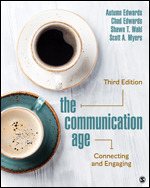Description
Test Bank for The Communication Age Connecting and Engaging, 3rd Edition, Autumn Edwards, Chad Edwards, Shawn T. Wahl, Scott A. Myers
Table Of Content
PREFACE
ACKNOWLEDGMENTS
ABOUT THE AUTHORS
1. Communication in the 21st Century
The Communication Age
Benefits of Studying Communication
What Is Communication?
Contexts of Communication
Communication Metaphors
Communication Competence
Communication Ethics
Connecting and Engaging in Communication
2. Perception, Self, and Communication
Perception and Communication
Self and Communication
Perception, Self, Communication, and Convergence
3. Verbal Communication
Verbal versus Nonverbal Communication
The Building Blocks of Language
Functions of Verbal Messages
Production and Interpretation of Verbal Messages
Verbal Communication and Convergence
4. Nonverbal Communication
Why Does Nonverbal Communication Matter?
Functions of Nonverbal Communication
Codes of Nonverbal Communication
Improving Your Nonverbal Communication Skills
Nonverbal Communication and Convergence
5. Listening
Hearing versus Listening
Listening Problems
Benefits of Being a Good Listener
Types of Listening
Becoming a Better Listener
Listening and Convergence
6. Communication, Culture, and Diversity
Culture and Diversity Defined
Cultural Awareness
Cultural Competence
Examples of Diversity across Communication Contexts
Barriers to Communication, Culture, and Diversity
Communication, Culture, Diversity, and Convergence
7. Interpersonal Communication
Forming Relationships
Models of Relationship Formation
Communication of Interpersonal Relationships
Interpersonal Communication and Convergence
8. Small Group and Team Communication
What Is Small Group Communication?
Small Group Development
Small Group Member Roles and Leadership
Small Group Conflict
Small Group and Team Communication and Convergence
9. Workplace and Organizational Communication
What Is Workplace Communication?
Workplace Culture
Workplace Socialization
Workplace Dissent
Workplace Relationships
Workplace and Organizational Communication and Convergence
10. Communication and New Media
Communication Traditions and Technology
New Media: Connecting and Engaging
Characteristics of New Media Theory
Presenting Your Online Identity
New Media as Your Community
New Media and Convergence
11. Selecting and Researching Your Topic and Knowing Your Audience
What Is the Purpose and Type of Your Presentation?
How Do I Choose a Topic?
Audience Analysis
Plagiarism
Building Credibility with Research
Finding Information
The Basics of Your Presentation
Selecting and Researching Your Topic and Knowing Your Audience and Convergence
12. Organizing Your Presentation
Telling a Story
Organizational Patterns
Introducing the Topic
Body
Conclusion
Transitions
Outlines
Time Considerations
Organizing Your Presentation and Convergence
13. Delivering Your Presentations
How to Reduce Your Anxiety and Fear over Presentations
Methods of Delivery
Effective Delivery Skills
Multimedia Presentational Aids
Delivery in Presentations and Convergence
14. Informative Presentations
The Difference between Informative and Persuasive Presentations
Relating Your Topic to the Audience
Types of Informative Presentations
Strategies for Informative Presentations
Samples of Informative Presentations
Informative Presentations and Convergence
15. Persuasive Presentations
Types of Persuasive Claims
Crafting Persuasive Arguments
Strategies to Persuade
Organizing Your Persuasive Presentation
Samples of Persuasive Presentations
Persuasive Presentations and Convergence
Appendix: Interviewing in the Communication Age
Basics of Interviewing
Types of Questions
Structure of the Interview
The Interview Environment
Types of Interviews
Interviewing and Convergence
GLOSSARY
REFERENCES
INDEX
 Test bank for Economics (Macro Part) 7th 9780132555234
1 × $55.00
Test bank for Economics (Macro Part) 7th 9780132555234
1 × $55.00  Test bank for Nutrition & You Core Concepts for Good Health 0321897226
1 × $55.00
Test bank for Nutrition & You Core Concepts for Good Health 0321897226
1 × $55.00  Test Bank for Business Communication 16th Edition by Lehman
1 × $35.00
Test Bank for Business Communication 16th Edition by Lehman
1 × $35.00 

Reviews
There are no reviews yet.